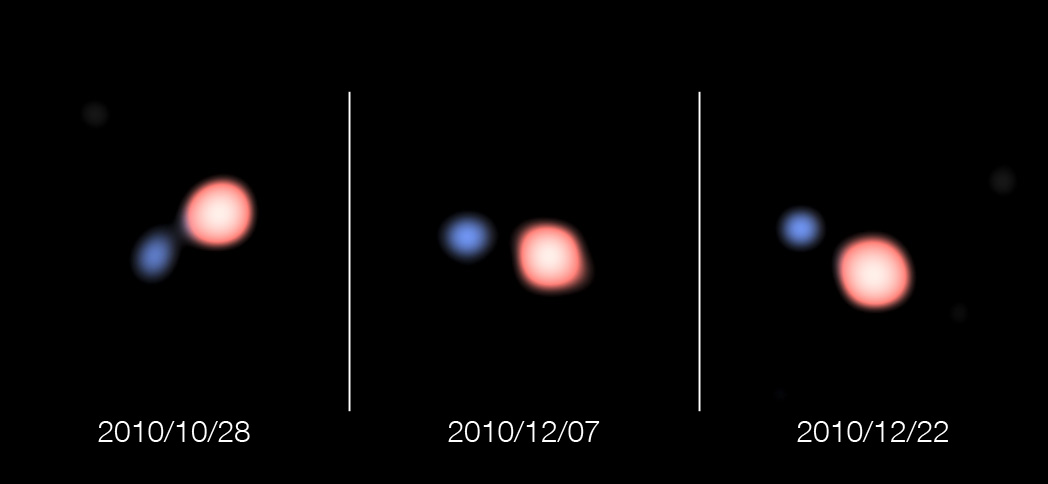Vampire Star's 'Gentle' Bite Captured in New Images

The best images yet of a vampire star siphoning material from its stellar companion have been captured by combining the powers of multiple telescopes at a European observatory in Chile.
The light from four telescopes at the European Southern Observatory's Paranal Observatory was joined to create the new images of the double star system. From these observations, astronomers found that the active transfer of mass from one star to the other in this system is gentler than they expected.
By harnessing light from the different telescopes that make up the Very Large Telescope (VLT), the astronomers were able to scan a portion of the sky 427 feet (130 meters) across with vision 50 times sharper than the venerable Hubble Space Telescope, according to officials at the European Southern Observatory.
"We can now combine light from four VLT telescopes and create super-sharp images much more quickly than before," study lead author Nicolas Blind, of the Institut de Planetologie et d'Astrophysique de Grenoble in France, said in a statement. "The images are so sharp that we can not only watch the stars orbiting around each other, but also measure the size of the larger of the two stars." [Video: Star-Sucker Caught in the Act ]
The unusual double star system, called SS Leporis, lies in the constellation of Lepus (The Hare), and consists of a red giant star orbiting a hotter companion.
Red giants are swollen stars that have begun to exhaust their hydrogen fuel and are nearing their eventual demise.
The two stars of SS Leporis circle each other every 260 days and are separated by little more than the distance between Earth and the sun, the astronomers said. The larger and cooler star of the pair extends to about a quarter of this distance, which is roughly equivalent to the orbit of Mercury.
Get the Space.com Newsletter
Breaking space news, the latest updates on rocket launches, skywatching events and more!
The new images are so sharp that they have enabled astronomers to measure the red giant star more accurately than ever before. Since the stars are so close to one another, the hotter companion has already cannibalized about half of the mass of the red giant, the researchers explained.

"We knew that this double star was unusual, and that material was flowing from one star to the other," said study co-author Henri Boffin, of the European Southern Observatory. "What we found, however, is that the way in which the mass transfer most likely took place is completely different from previous models of the process. The 'bite' of the vampire star is very gentle but highly effective."
The new observations show that the red giant star is actually smaller than was previously thought, which makes it more difficult to explain how this star lost matter to its companion, the astronomers said. To readjust their theory, the researchers now think that matter must be ejected from the giant star as stellar wind that is captured by the hotter companion, rather than simply streaming from one star to the other.
"These observations have demonstrated the new snapshot imaging capability of the Very Large Telescope Interferometer," study co-author Jean-Philippe Berger said. "They pave the way for many further fascinating studies of interacting double stars."
Follow SPACE.com for the latest in space science and exploration news on Twitter @Spacedotcom and on Facebook.
Join our Space Forums to keep talking space on the latest missions, night sky and more! And if you have a news tip, correction or comment, let us know at: community@space.com.

Space.com is the premier source of space exploration, innovation and astronomy news, chronicling (and celebrating) humanity's ongoing expansion across the final frontier. Originally founded in 1999, Space.com is, and always has been, the passion of writers and editors who are space fans and also trained journalists. Our current news team consists of Editor-in-Chief Tariq Malik; Editor Hanneke Weitering, Senior Space Writer Mike Wall; Senior Writer Meghan Bartels; Senior Writer Chelsea Gohd, Senior Writer Tereza Pultarova and Staff Writer Alexander Cox, focusing on e-commerce. Senior Producer Steve Spaleta oversees our space videos, with Diana Whitcroft as our Social Media Editor.









